Welcome to the connected home of 2025. Choosing from the best smart home systems can feel overwhelming, with countless brands, protocols, and platforms all promising to simplify your life. The challenge isn't just picking a device; it's selecting an ecosystem that aligns with your specific needs, budget, and technical comfort level.
Are you looking for a simple, voice-controlled lighting setup, a robust security network, or a fully integrated system that learns your habits to save energy? This guide cuts through the noise. We move beyond generic feature lists to provide an in-depth, practical analysis of the top platforms and retailers where you can build your ideal setup. We dive into real-world performance, compatibility strengths, hidden limitations, and ideal use cases to give you the clarity needed to invest wisely.
This resource is your blueprint for creating a home that is truly intelligent and responsive. We will explore each ecosystem, complete with direct links and screenshots, to help you visualize how these systems operate. Whether you're a homeowner starting with a single smart speaker or a tech enthusiast planning a complex automation network, this comprehensive comparison will help you find the perfect smart home system. We provide the honest assessments and side-by-side details required to make an informed decision and avoid costly compatibility mistakes.
1. Amazon – Smart Home
As the world's largest online retailer, Amazon stands as the undisputed starting point for anyone exploring the best smart home systems. Its sheer scale and massive product catalog make it an essential resource for both beginners assembling their first setup and veterans hunting for niche devices. The platform’s primary strength is its unparalleled selection, where you can find nearly every major smart home brand and protocol, often at highly competitive prices.
Navigating the Ecosystem
The user experience is centered around powerful search and filtering tools. You can narrow down choices by brand, device type (lighting, security, thermostats), and, most importantly, by compatibility using the 'Works with Alexa' filter. This integration is key, as it helps you build a cohesive system around Amazon's own ecosystem. User reviews and the detailed Q&A section are invaluable for real-world feedback, often revealing quirks or compatibility issues not mentioned in official product descriptions.
Pro Tip: Pay close attention to the "Sold by" and "Shipped from" information on product pages. Stick with items sold or fulfilled by Amazon to ensure authentic products, easier returns, and reliable customer service.
Practical Considerations
While the selection is vast, it can also be overwhelming. Listings for product bundles can be confusing, sometimes including older model years or unclear contents. The marketplace structure means product quality can vary significantly between sellers.
- Pros: The broadest product availability, frequent deals (especially during Prime Day), and the convenience of Prime shipping and returns.
- Cons: Marketplace listings can be inconsistent, and it's easy to accidentally purchase gray market items from third-party sellers.
For those committed to building a smart home, Amazon is a foundational, one-stop shop that provides the components, user feedback, and logistical ease to get started.
Website: https://www.amazon.com/smart-home
2. Best Buy – Smart Home
For those who prefer a hands-on approach, Best Buy offers a crucial "try-before-you-buy" experience for building the best smart home systems. As a major electronics retailer with a strong physical and online presence, it bridges the gap between digital research and real-world application. Its primary advantage is the ability to see, touch, and compare devices from competing ecosystems side-by-side, which is invaluable for judging build quality, size, and responsiveness.
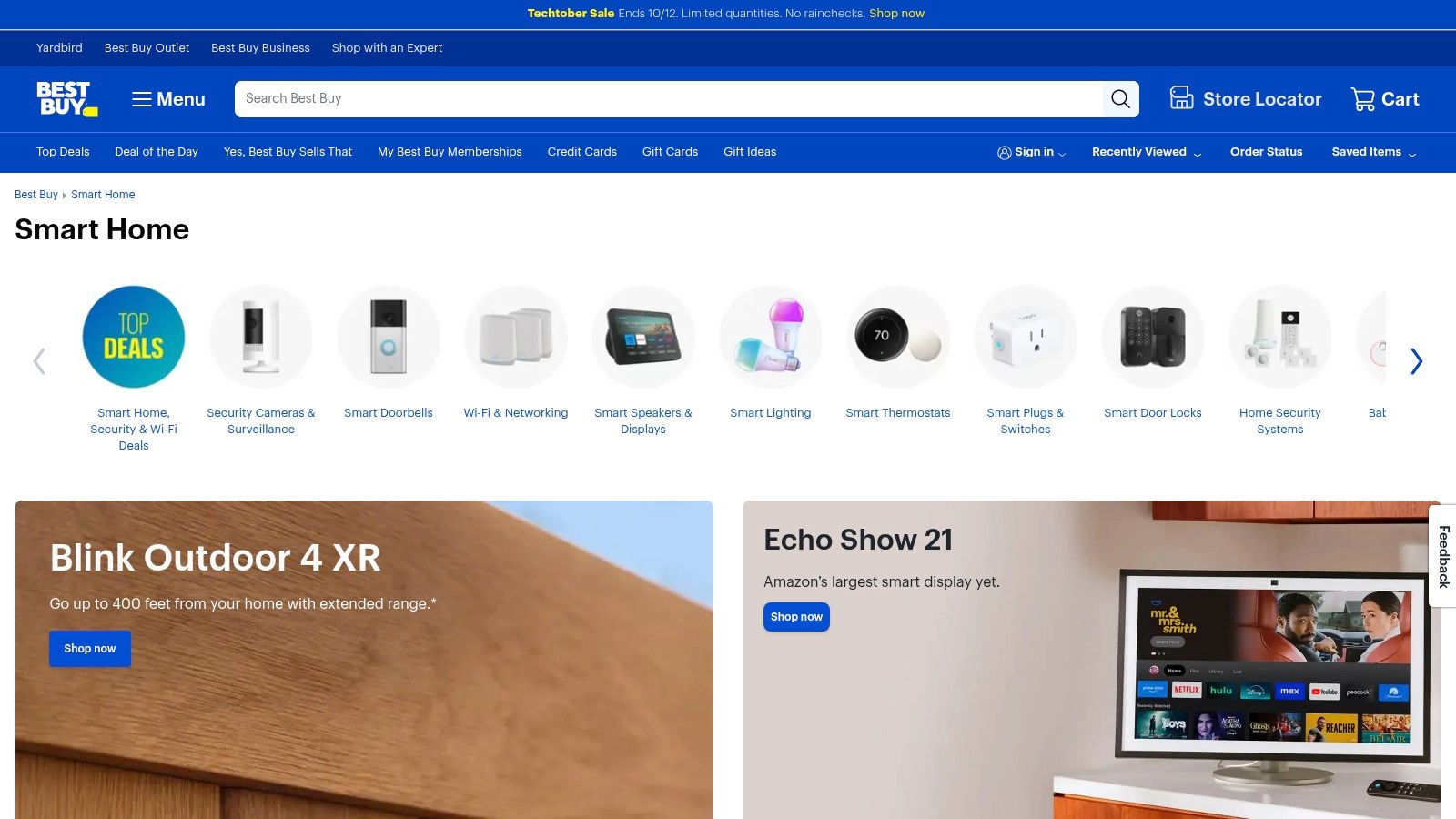
Navigating the Ecosystem
Best Buy’s website and physical stores are organized to simplify system building. Online, the dedicated Smart Home category allows you to filter products by voice assistant compatibility (Google Assistant, Alexa, Siri) and hub requirements. In-store, dedicated sections often feature interactive displays and knowledgeable associates who can provide practical advice and demonstrate how different products work together. This in-person support is a significant benefit over online-only retailers.
Pro Tip: Keep an eye on Best Buy's "Open-Box" deals, often found in a dedicated section of the store or online. You can find perfectly good, returned smart home gear at a significant discount, backed by a reliable return policy.
Practical Considerations
While Best Buy offers a well-curated selection, it may not stock the same vast range of niche or emerging brands as a massive online marketplace. Product availability can also vary by store location. It’s also wise to be cautious of older, store-brand smart devices, as some have lost cloud support in the past, rendering them non-functional.
- Pros: In-person device demos, knowledgeable staff, convenient local pickup and returns, and access to professional installation services.
- Cons: Product selection is less comprehensive than online giants, and stock can be inconsistent between different store locations.
Best Buy excels as a resource for tangible comparisons and expert guidance, making it an ideal starting point for beginners who want confidence in their purchasing decisions.
Website: https://www.bestbuy.com/site/smart-home/pcmcat254000050002.c?id=pcmcat254000050002
3. The Home Depot – Smart Home (+ Hubspace)
As a go-to destination for DIYers and contractors, The Home Depot has become a key player in the market for the best smart home systems, particularly for those undertaking larger home improvement projects. Its strength lies in integrating smart technology directly into the core categories of home renovation like lighting, security, and climate control. The platform is especially noteworthy for its exclusive Hubspace ecosystem, offering a simplified, hub-free approach to home automation.
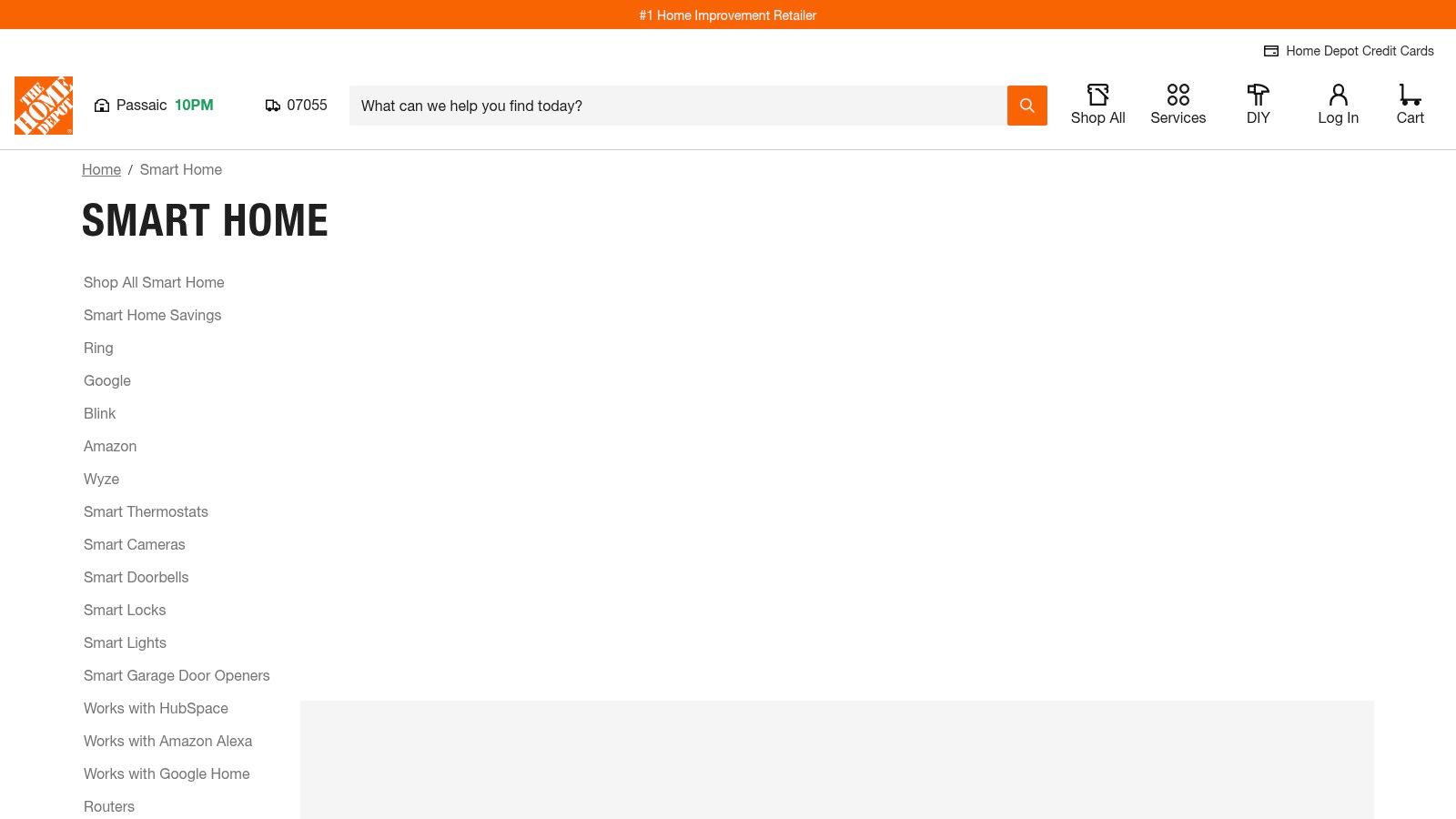
Navigating the Ecosystem
The Home Depot’s website and in-store aisles are organized to make finding compatible products straightforward. Online, you can filter extensive categories by compatibility with Hubspace, Google Assistant, or Alexa, streamlining the process of building a cohesive system. The Hubspace platform itself is a major draw, powering store brands like Hampton Bay and Defiant. This allows for an incredibly cost-effective setup using simple Wi-Fi devices that are easily controlled through a single app without needing a dedicated physical hub, a topic you can explore in our smart home hub comparison.
Pro Tip: When shopping in-store, look for the bright orange Hubspace logo on packaging. This is a quick visual cue that the device will integrate seamlessly into their budget-friendly ecosystem.
Practical Considerations
The Home Depot excels at offering project-based solutions and value bundles, making it easy to purchase everything from smart ceiling fans to video doorbells in one trip. The convenience of same-day pickup or in-store returns adds significant value. However, the Hubspace ecosystem is focused primarily on Wi-Fi devices, which means it lacks some of the advanced automations and local control features found in Z-Wave or Zigbee-based systems.
- Pros: Excellent for project-based shopping, easy in-store returns and pick-up, and the affordable, hub-free Hubspace platform.
- Cons: Hubspace offers fewer advanced features than dedicated hubs, and product selection can vary significantly between physical store locations.
For homeowners looking to integrate smart technology into their renovations, The Home Depot provides a practical, project-focused retail experience with a compelling entry-level ecosystem.
Website: https://www.homedepot.com/b/Smart-Home/N-5yc1vZc1jw
4. Lowe’s – Smart Home
As a leading home improvement retailer, Lowe’s offers a curated but powerful selection of some of the best smart home systems on the market. Its strength lies in providing essential, high-demand devices that cater directly to home renovation and security projects. This makes it a go-to destination for homeowners looking to integrate smart technology as part of a larger upgrade, rather than just buying standalone gadgets.
Navigating the Ecosystem
The Lowe's website organizes its smart home offerings into clear, project-oriented categories like security, lighting, and climate control. You can filter by brand, device type, or compatibility with major voice assistants. The platform excels at showing you what's physically available at your local store, a key advantage for those who need an item immediately or prefer to see it before buying. Product pages often include helpful installation guides and "shop the look" features.
Pro Tip: Use the Lowe's mobile app to check in-store stock before you go. This can save a wasted trip, as inventory levels for specific smart home products can vary significantly between locations.
Practical Considerations
While Lowe's doesn't have the exhaustive catalog of a massive online marketplace, its selection is well-chosen and focused on reliable, mainstream brands. The biggest benefit is the convenience of its physical stores, which allows for easy, no-hassle returns and the ability to get expert advice from store associates.
- Pros: Competitive pricing with frequent sales and promotions, and the unmatched convenience of local store pickup and returns.
- Cons: In-store inventory can be uneven or limited, and there are fewer curated system bundles compared to some rivals.
For those undertaking home improvement projects, Lowe's provides a practical and accessible entry point into smart home technology with the added security of a brick-and-mortar presence.
Website: https://www.lowes.com/pl/smart-home/37721669146452
5. Walmart – Smart Home
As a retail giant, Walmart offers a surprisingly robust and budget-friendly entry point into the best smart home systems. It excels in providing accessible, value-oriented devices from a wide array of third-party brands, making it an ideal destination for shoppers who prioritize cost-effectiveness. The platform is particularly strong in core categories like smart lighting, security cameras, and smart plugs, offering recognizable names alongside its own onn. brand.
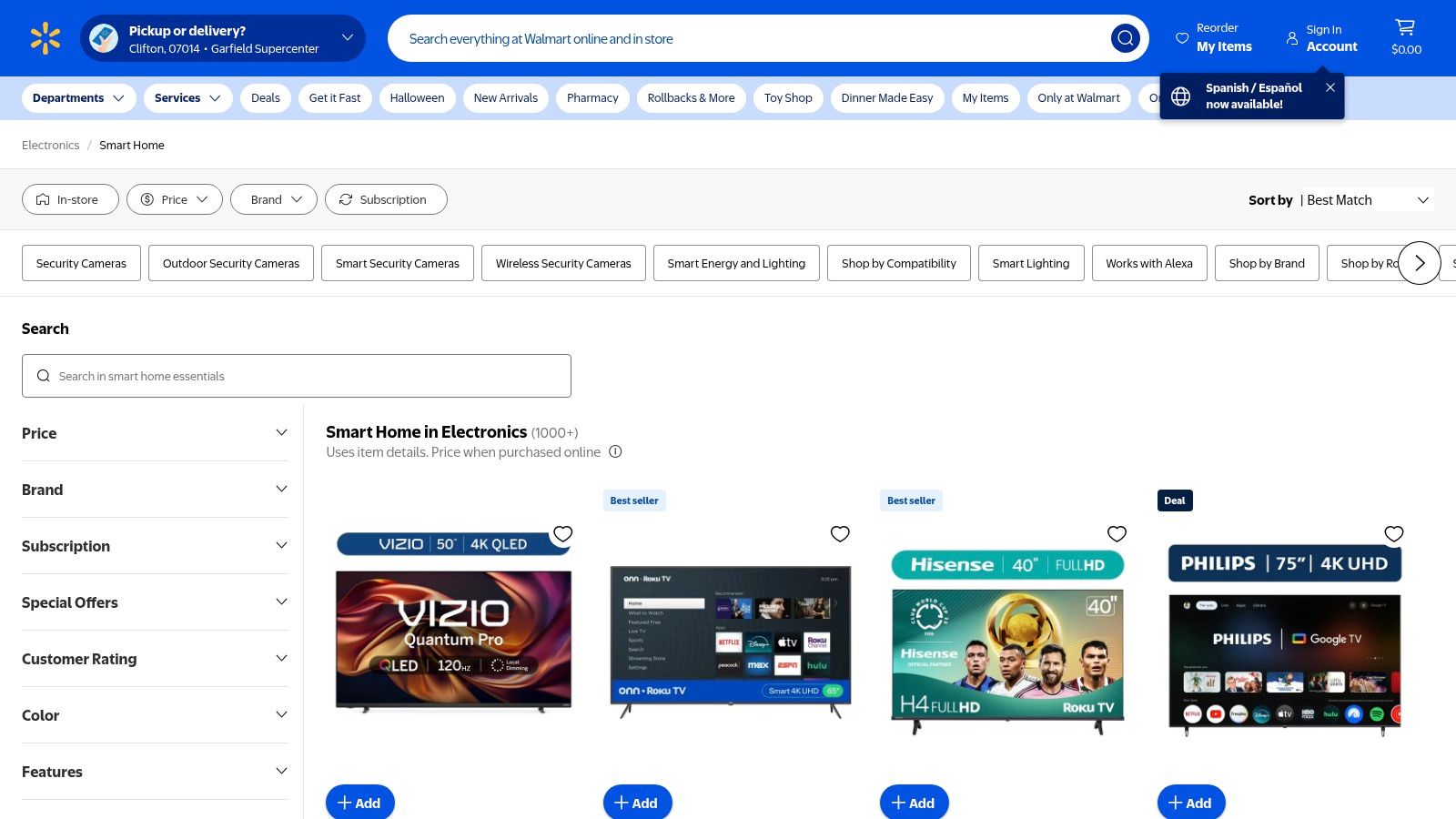
Navigating the Ecosystem
The website organizes its smart home offerings into clear categories and includes a helpful "Shop by Room" feature, allowing you to visualize and purchase items for specific areas like the living room or kitchen. While its filtering tools aren't as granular as some competitors, they cover the essentials. Walmart’s key differentiator is its physical footprint, enabling convenient local pickup and in-person returns for many online orders, a significant advantage over online-only retailers.
Pro Tip: Leverage Walmart's same-day delivery or store pickup options for urgent needs, like replacing a burnt-out smart bulb or grabbing an extra security camera before a trip. This convenience is unmatched by most competitors.
Practical Considerations
While Walmart is excellent for budget to midrange devices, you will find fewer premium or professional-grade products compared to specialty electronics stores. Like Amazon, it operates a third-party marketplace, so it’s crucial to check seller ratings and return policies before purchasing, as they can vary greatly.
- Pros: Aggressive pricing on many popular items, wide variety of third-party brands, and the major convenience of local returns and pickup.
- Cons: Marketplace listings can be inconsistent, and the selection of high-end or niche smart home devices is limited.
For the value-conscious consumer, Walmart provides an unbeatable combination of aggressive pricing and logistical convenience, making it a powerful resource for building out a smart home without breaking the bank.
Website: https://www.walmart.com/browse/3944_1229875
6. eBay – Smart Home Hubs and Systems
For enthusiasts and bargain hunters, eBay provides a unique marketplace for building out some of the best smart home systems by offering access to new, used, and discontinued devices. It’s an invaluable resource for finding legacy hardware like older Nest Hubs or SmartThings controllers, which might be necessary to support specific protocols or integrate with vintage smart gadgets. The platform thrives on its vast network of individual and business sellers, creating a treasure trove of components that are no longer available through traditional retail channels.
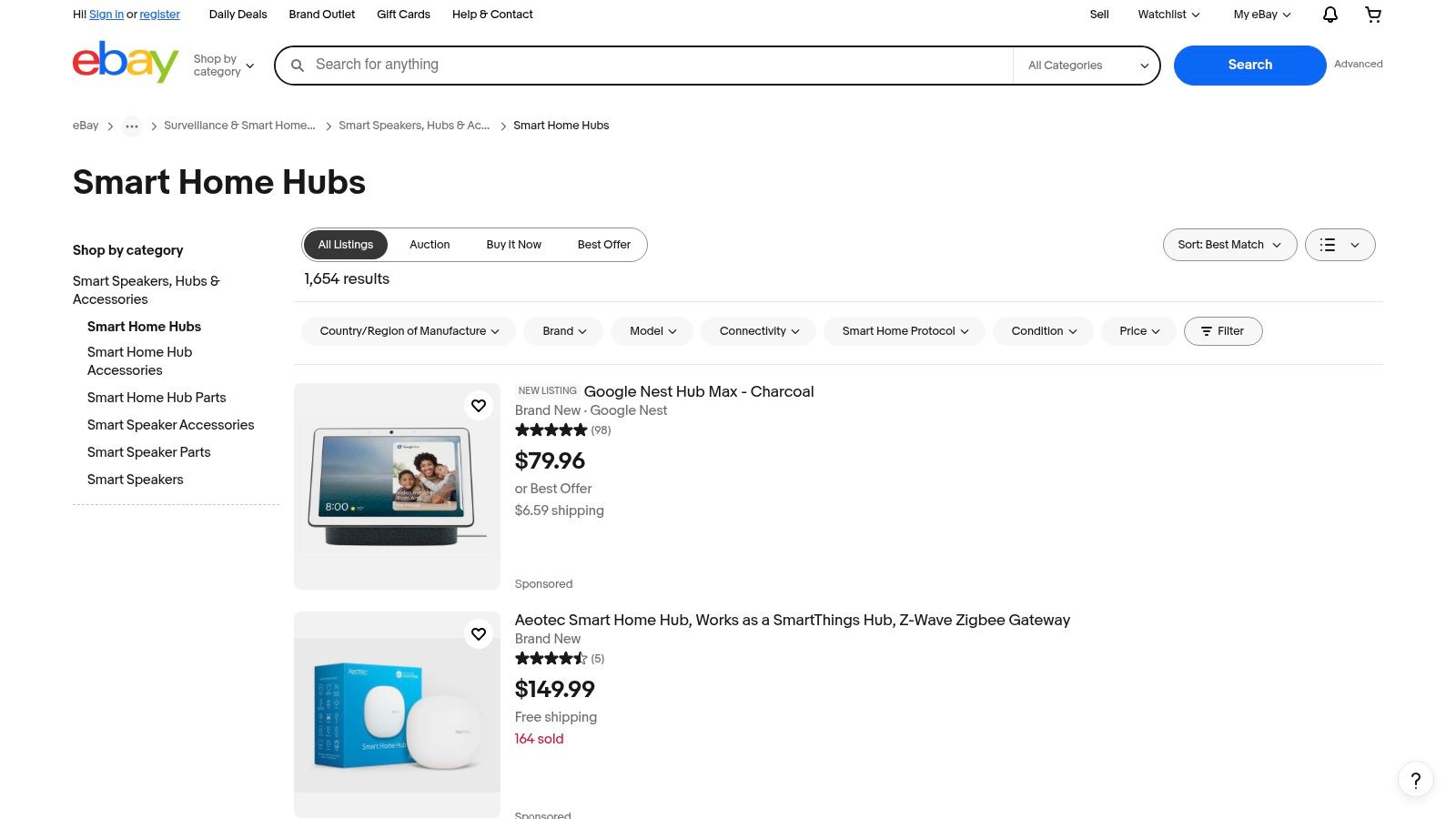
Navigating the Ecosystem
Success on eBay requires a different approach than a standard retailer. The user experience is built around auctions and "Buy It Now" listings, where careful reading of descriptions is paramount. Filters for item condition (new, used, refurbished) and buying format are essential tools for finding what you need. A seller's rating and recent feedback history are the most critical indicators of a trustworthy transaction, offering insight into their reliability and product quality.
Pro Tip: Use the "Save this search" feature for rare or specific items. eBay will notify you when a new listing matches your criteria, giving you an advantage in securing hard-to-find smart home components before they're gone.
Practical Considerations
While eBay opens the door to incredible deals and rare finds, it also carries inherent risks. The condition of used items can be subjective, and warranties are often non-existent unless the product is certified refurbished by an authorized seller. Buyers must be diligent in vetting both the product listing and the seller to avoid disappointment.
- Pros: Unmatched access to rare, legacy, and discontinued smart home gear, and highly competitive prices on both new and refurbished items.
- Cons: Buyers must carefully vet sellers and item condition, with limited warranty and support on most used or refurbished purchases.
For the resourceful user, eBay is an essential secondary market for sourcing the specific hubs and controllers needed to complete or maintain a highly customized smart home setup.
Website: https://www.ebay.com/b/Smart-Home-Hubs/185068/bn_115384837
7. Google – Google Store and Google Home
For those building their smart home around the Google Assistant, the official Google Store is the definitive starting point. It serves as the primary retail hub for the entire Nest and Google Home product line, including smart speakers, displays, thermostats, cameras, and doorbells. This platform is less about overwhelming choice and more about providing a curated, first-party experience, making it one of the best smart home systems for users who prioritize seamless ecosystem integration and official support.
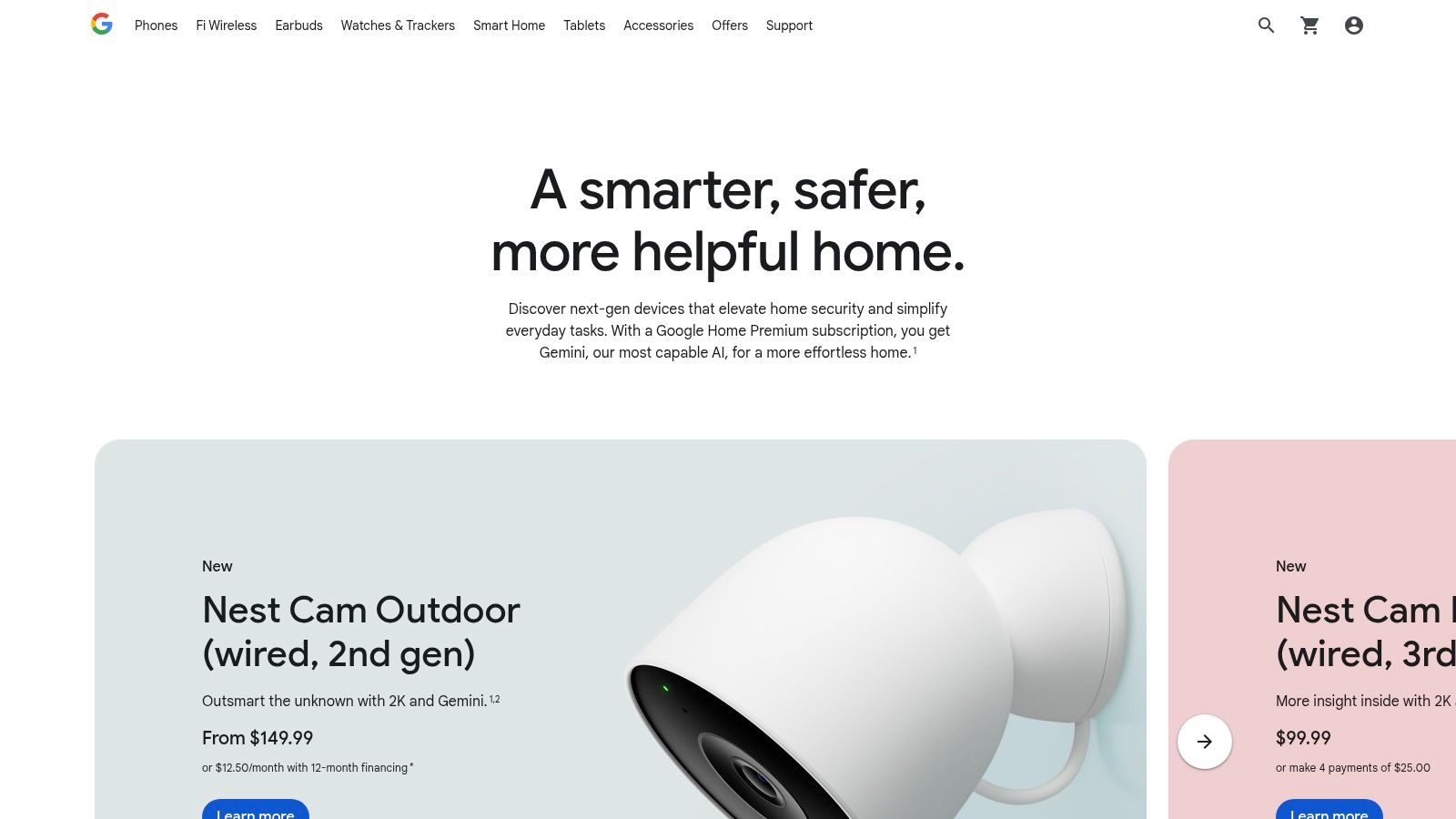
Navigating the Ecosystem
The website is clean and minimalist, focusing on explaining how Google’s devices work together through the Google Home platform. It provides clear details on automations, Matter support, and controls via the Google Home app. Unlike third-party retailers, the Google Store is the most reliable source for information on official partner integrations and future software updates, ensuring you have the most accurate compatibility data.
Pro Tip: Check the “Special Offers” section frequently. The Google Store often runs exclusive promotions and bundles, particularly around new product launches or seasonal events, that aren't available elsewhere.
Practical Considerations
While the store guarantees authentic products with official warranties, the product release cycle can feel inconsistent. Some legacy devices may be discontinued or are in the process of migrating between the older Nest app and the newer Google Home app, which can cause confusion for long-time users.
- Pros: Guaranteed authentic products with official warranty and first-party support, clear ecosystem information, and regular platform updates.
- Cons: Stock levels and new product availability can be inconsistent, and the transition of some legacy devices between apps can be clunky.
For users committed to the Google ecosystem, the Google Store is the most direct and trustworthy source for hardware and platform knowledge.
Website: https://store.google.com/category/connected_home
8. Apple – Smart Home (Apple Home / HomeKit accessories)
For users deeply invested in the Apple ecosystem, the official Apple Smart Home storefront is the definitive starting point. Rather than aiming for an exhaustive catalog, Apple provides a curated selection of premium accessories guaranteed to work seamlessly with Apple Home (formerly HomeKit). This focus on a walled-garden approach makes it one of the best smart home systems for those prioritizing privacy, security, and a frictionless user experience over sheer device quantity.
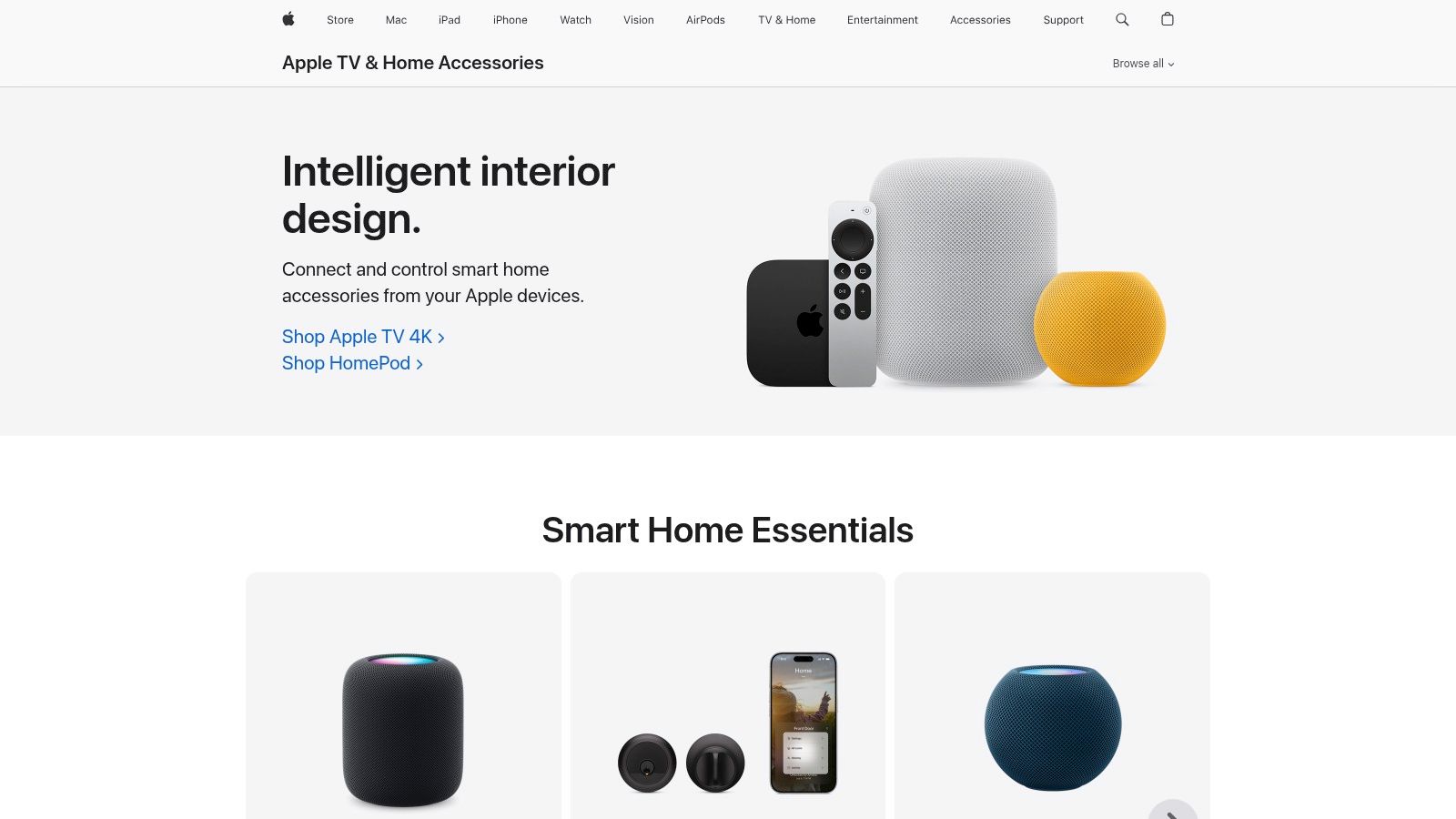
Navigating the Ecosystem
The shopping experience mirrors Apple’s minimalist design philosophy, offering a clean, uncluttered interface. Products are categorized by type, such as lighting, cameras, and sensors, with a clear "Works with Apple Home" badge on every item. Unlike sprawling marketplaces, every product listed has been vetted for compatibility, removing the guesswork often associated with building a smart home. The integration with first-party devices like HomePod or Apple TV as a hub is a core advantage.
Pro Tip: Look for accessories that support Matter over Thread. This newer standard, prominently featured on Apple’s site, ensures your devices will be more interoperable and future-proof, even if you decide to integrate other ecosystems later.
Practical Considerations
Apple's strength is its curated quality, which is also its main limitation. The selection is significantly narrower than what you'll find on Amazon or at Best Buy, and prices can be higher for certain brands. However, the benefits of buying direct include transparent pricing, fast and reliable shipping, straightforward returns, and access to Apple’s renowned customer support.
- Pros: Strong privacy and security controls, seamless setup and integration for Apple users, and reliable first-party support.
- Cons: Selection is limited compared to other retailers, and some accessories carry a premium price tag.
For those committed to the Apple ecosystem, this storefront offers a secure and streamlined way to purchase high-quality, compatible devices.
Website: https://www.apple.com/shop/smart-home/accessories
9. Samsung SmartThings – Official
Samsung's official SmartThings site serves as the central hub for one of the most versatile and protocol-agnostic best smart home systems available. Unlike retailer-focused sites, this platform is an informational gateway into a powerful ecosystem that bridges devices from hundreds of brands. Its primary function is to educate users on the capabilities of the SmartThings app and the extensive 'Works with SmartThings' certified device list, which includes support for Zigbee, Z-Wave (on older hubs), Thread, and Matter.
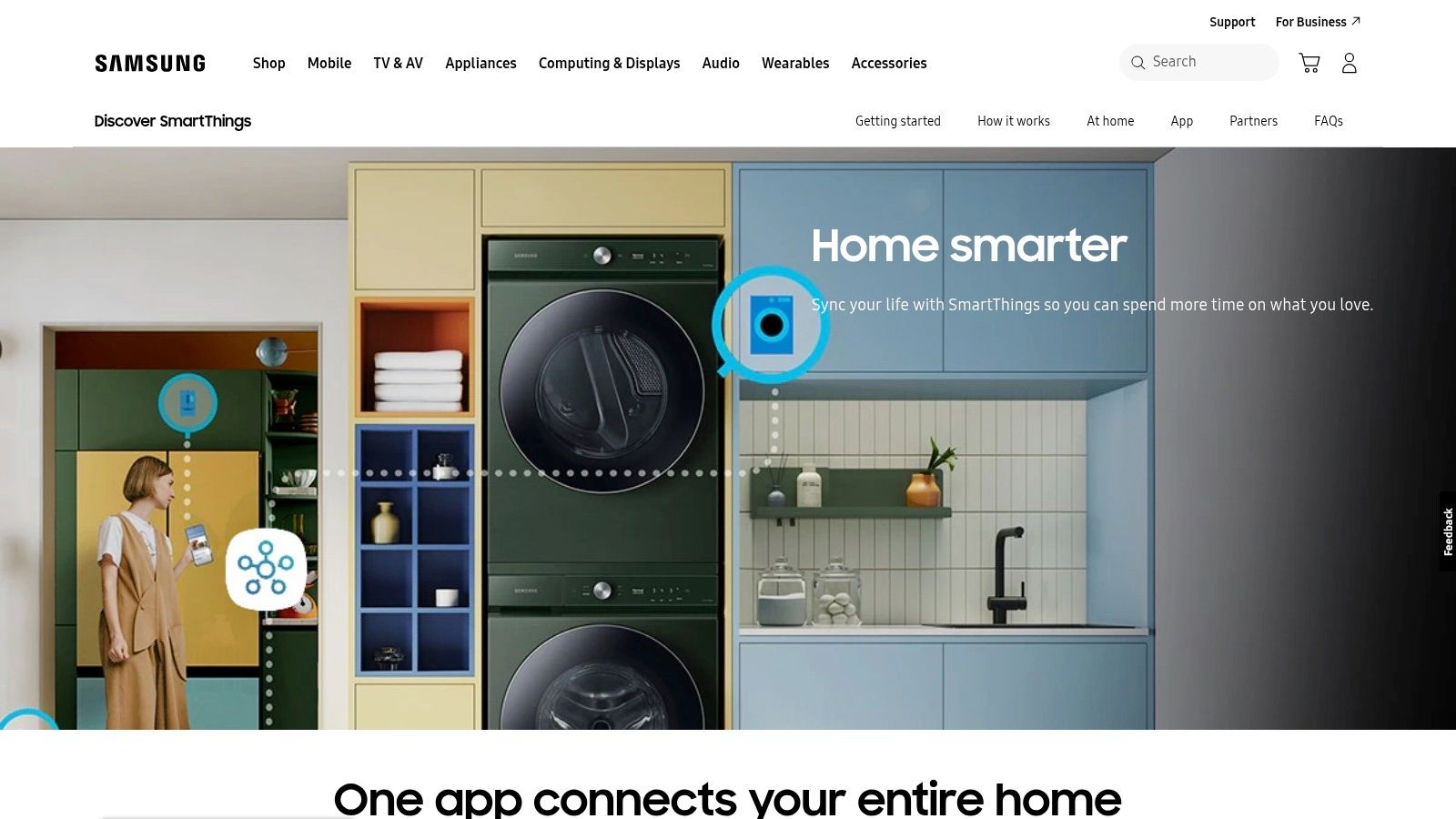
Navigating the Ecosystem
The website is designed to showcase the platform's breadth rather than sell products directly. Users can explore supported device categories, understand how to build automations (called Routines), and discover how SmartThings is embedded within Samsung's wider product family, like TVs and appliances. The site effectively guides you toward understanding what you need, whether it's a dedicated hub like the SmartThings Station or just the free app for cloud-based integrations.
Pro Tip: Before buying a new smart device, check the 'Works with SmartThings' section on the site. This ensures seamless integration and avoids the frustration of purchasing an incompatible product.
Practical Considerations
The platform's strength is its incredible interoperability, allowing you to mix and match brands freely. However, the experience can vary depending on your hardware; newer hubs support local processing for faster response times, while older ones rely more on the cloud. The phasing out of Z-Wave support in newer first-party hubs is a key consideration for those with existing Z-Wave devices.
- Pros: Exceptional device and brand compatibility, powerful and free automation app, and integration with major voice assistants.
- Cons: Protocol support is dependent on the specific hub generation, and achieving the best performance may require a dedicated hub.
For users wanting to create a truly customized smart home that isn't locked into a single brand, the SmartThings platform is an essential resource for planning and execution.
Website: https://www.samsung.com/us/samsung-smartthings/
10. Philips Hue – Official Store
For those who believe that lighting is the cornerstone of a truly smart home, the official Philips Hue store is the definitive starting point. As one of the most mature and reliable ecosystems, Philips Hue offers a seamless, lighting-first approach to automation. The official website serves as the central hub for its complete product lineup, from the iconic color ambiance bulbs and light strips to outdoor fixtures, motion sensors, and the recently introduced Secure cameras.
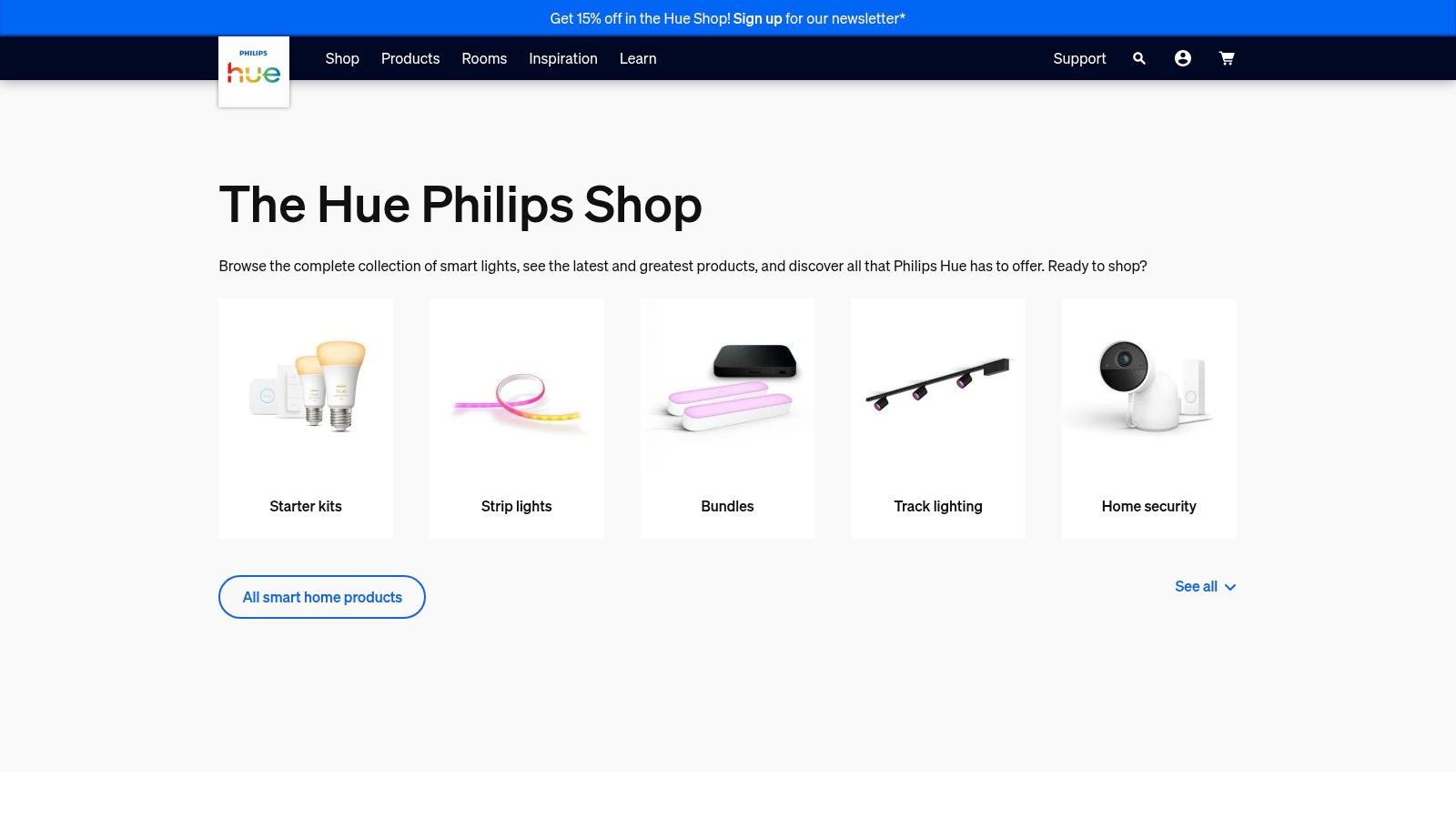
Navigating the Ecosystem
The website is cleanly organized, allowing you to explore products by room or category, making it easy to visualize how different lighting solutions will work in your space. Its primary value is ensuring you are purchasing authentic, up-to-date products directly or through a network of verified authorized dealers. This is crucial for avoiding counterfeit items and guaranteeing warranty support. The platform excels at showcasing the rich automations and dynamic scenes possible within the Hue app, which remains a benchmark for user-friendly lighting control. For more insights, you can learn about the best smart lighting systems and see how Hue compares.
Pro Tip: Before committing, use the site's "What is Hue?" and inspiration sections. They provide excellent use-case scenarios and recipes for lighting scenes that you can implement immediately, such as "sync with music" or "wake-up" automations.
Practical Considerations
While Hue is a leader in lighting, its premium pricing can be a significant investment, especially when outfitting an entire home. The system's new security cameras are a welcome addition, but they are not as feature-rich as those from dedicated security brands.
- Pros: A mature, reliable, and polished lighting ecosystem with extensive third-party integrations (Alexa, Google, Apple Home, and Matter).
- Cons: Premium price point across the entire product range, and its home security offerings are still developing.
For anyone prioritizing ambiance, reliability, and deep integration, the Philips Hue ecosystem remains one of the best smart home systems to build upon.
Website: https://www.philips-hue.com/en-us/products
11. Ring – Official Store
As an Amazon-owned company, Ring has carved out a distinct niche in the smart home market by focusing almost exclusively on security. The official Ring website is the definitive source for its ecosystem of video doorbells, security cameras, and the Ring Alarm system, making it one of the best smart home systems for users who prioritize safety and surveillance. Its primary strength is offering a unified, security-first platform with tightly integrated hardware and optional professional monitoring.
Navigating the Ecosystem
The Ring website is designed to guide users toward a complete security solution. It prominently features product bundles, which are often the most cost-effective way to get started. You can easily browse by category- Doorbells, Security Cams, or Alarm- and the site provides clear comparison charts to help differentiate between models. A key part of the experience is understanding the Ring Protect subscription plans, which unlock video history and advanced features, detailed clearly in their own section.
Pro Tip: Look for the "Certified Refurbished" section on the Ring website. These products are tested and certified by Ring, come with the same warranty as new devices, and offer significant savings, especially when building a multi-camera setup.
Practical Considerations
While the hardware is designed for easy DIY installation, unlocking its full potential often requires a subscription. The free tier is quite limited, offering only live view and motion alerts without video storage. Additionally, privacy settings and features are constantly evolving, so it's wise to review and customize them within the app upon setup. For a deeper dive, you can explore various smart home security systems to compare options.
- Pros: Tightly integrated security ecosystem, frequent bundle deals and sales, and straightforward cloud storage and monitoring subscription options.
- Cons: Many essential features are locked behind a paid subscription, and privacy concerns remain a topic of discussion for some users.
For homeowners wanting a simple yet powerful security-focused smart home, the official Ring store is the ideal starting point for building a cohesive surveillance network.
Website: https://ring.com
12. Wyze – Official Store
Wyze has carved out a significant niche by offering some of the most budget-friendly devices in the smart home market, making its official store a prime destination for cost-conscious consumers. The platform is the direct source for its growing ecosystem of cameras, sensors, lighting, and home security products. Its main appeal lies in providing access to one of the best smart home systems for those who want functional automation without a hefty initial investment.
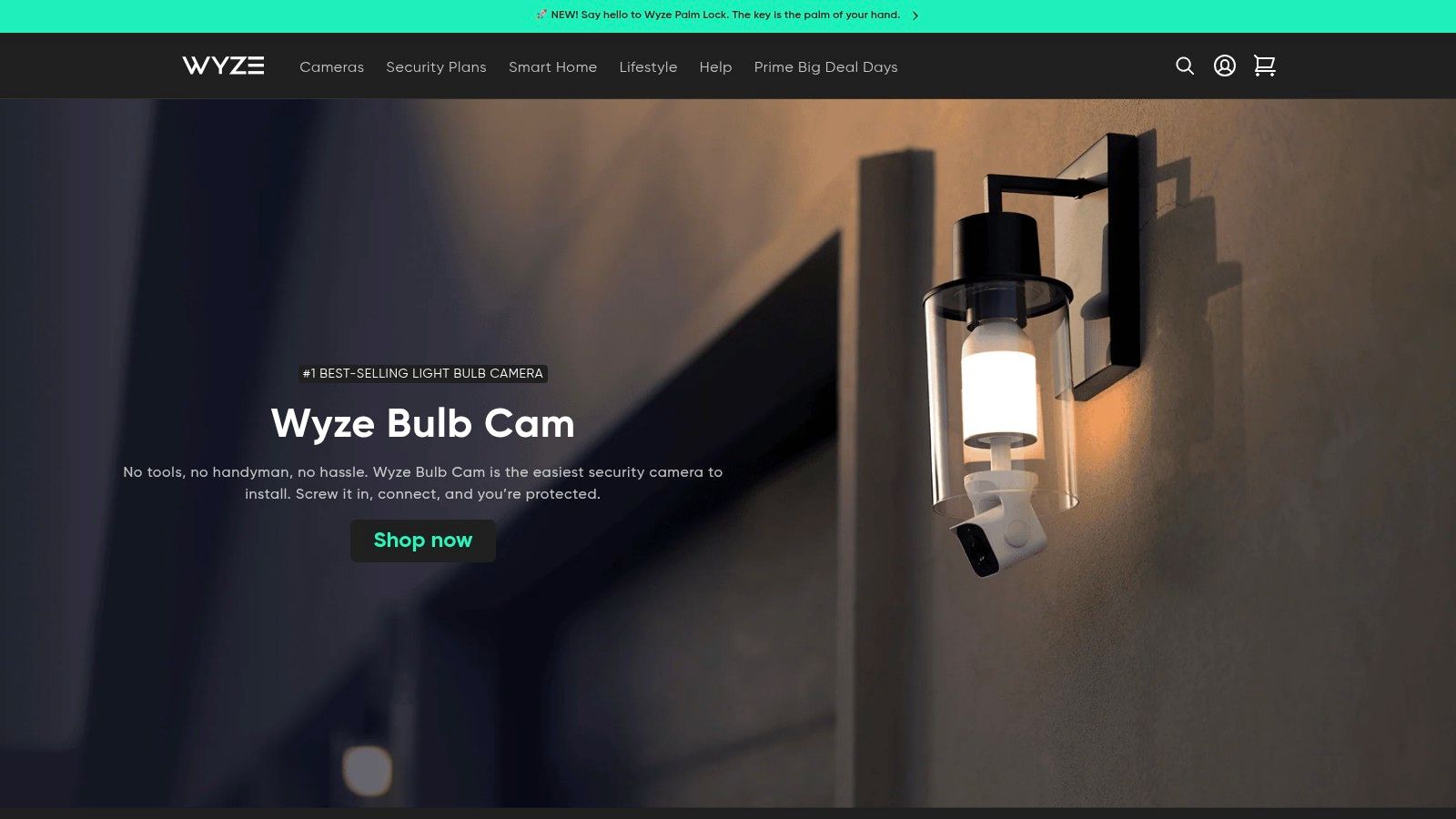
Navigating the Ecosystem
The Wyze website is clean and product-focused, making it simple to browse its distinct categories like cameras, home monitoring, and lighting. Product pages clearly detail specifications and compatibility within the Wyze app, which is the central hub for all device control and automation. The site frequently features bundle deals and promotions, especially for new product launches, offering even greater value.
Pro Tip: Always check Wyze's official list of authorized retailers before purchasing from a third-party site. This ensures you receive genuine products with a valid warranty, as unauthorized sellers on marketplaces can be a problem.
Practical Considerations
While the low price point is a major draw, it's important to manage expectations. The depth of third-party integrations is narrower compared to larger ecosystems, and device or app reliability can occasionally vary between models and firmware updates. The value proposition is centered on its own self-contained, app-driven environment.
- Pros: Extremely competitive pricing across a broad range of devices, straightforward setup process, and frequent deals directly from the manufacturer.
- Cons: App and device performance can be inconsistent, has a smaller third-party integration library, and requires vigilance against unauthorized sellers.
For those starting their smart home journey or looking to expand on a budget, the official Wyze store provides an accessible and direct entry point.
Website: https://www.wyze.com/
Top 12 Smart Home Systems Comparison
| Provider | Core Features / Ecosystem | User Experience ★★★★✩ | Value Proposition 💰 | Target Audience 👥 | Unique Selling Points ✨ | Price Points 💰 |
|---|---|---|---|---|---|---|
| Amazon – Smart Home | Huge device catalog, Prime shipping, customer reviews | Wide selection, reliable fulfillment | Competitive pricing, frequent deals | General smart home builders, bargain hunters | Massive selection, 'Works with' filters | Moderate to Low 💰💰💰 |
| Best Buy – Smart Home | In-store + online, voice assistant filters, local pickup | Hands-on trials, vendor demos | Professional installation, easy local returns | Hands-on buyers, installation seekers | Local pickup & demos | Moderate 💰💰 |
| The Home Depot – Smart Home (+ Hubspace) | Hubspace Wi-Fi devices, in-store + delivery options | Simple app support, bundles | Budget-friendly smart devices | DIYers, whole-home projects | Hubspace platform, job-site delivery | Low to Moderate 💰💰 |
| Lowe’s – Smart Home | Brand and device filters, mix of big and entry-level brands | Competitive pricing, local returns | Frequent promotions | Budget-conscious buyers | Frequent promotions | Low to Moderate 💰💰 |
| Walmart – Smart Home | Budget to midrange devices, same-day delivery | Wide variety, fast delivery | Aggressive pricing | Value shoppers, first-time smart home buyers | Same-day delivery, 'Shop by Room' | Very Low 💰💰 |
| eBay – Smart Home Hubs & Systems | New, used, legacy hubs, refurbished devices | Varies by seller, buyer protection | Bargains on rare/legacy items | Collectors, bargain hunters | Access to rare/legacy gear | Very Low 💰 |
| Google – Google Store & Home | Official Nest products, Google Home platform | Official support, ecosystem info | Warranty and updates | Google ecosystem users | First-party Google devices | Moderate to High 💰💰💰 |
| Apple – Smart Home (HomeKit) | Curated HomeKit accessories, strong privacy | Seamless Apple ecosystem integration | Privacy-focused, reliable support | Apple users, privacy advocates | Native HomeKit compatibility, privacy | High 💰💰💰 |
| Samsung SmartThings – Official | Broad device support, multi-protocol app | Robust automation, local control support | Platform-agnostic, broad compatibility | Tech-savvy users, multi-brand ecosystems | Protocol flexibility, embedded in Samsung devices | Moderate 💰💰 |
| Philips Hue – Official Store | Full lighting ecosystem, authorized resellers | Mature platform, rich automations | Premium lighting-focused ecosystem | Lighting-first smart homes | Rich effects, Matter support | High 💰💰💰 |
| Ring – Official Store | Security cameras, doorbells, subscriptions | Easy setup, DIY-friendly | Security-centric with subscription options | Home security focused users | Video surveillance, AI features | Moderate to High 💰💰💰 |
| Wyze – Official Store | Budget cameras, locks, lighting, growing ecosystem | Competitive pricing, simple setup | Affordable automation solutions | Cost-conscious buyers | Low-cost with cloud/AI features | Very Low 💰 |
Building Your Intelligent Home: Final Thoughts and Next Steps
Embarking on the journey to create a connected home is an exciting endeavor, but as we've explored, the path is not one-size-fits-all. The landscape of the best smart home systems is a dynamic mix of expansive ecosystems, specialized platforms, and innovative newcomers. Your final choice hinges less on finding a single "perfect" system and more on identifying the platform that aligns seamlessly with your lifestyle, technical comfort, and long-term vision for your home.
We have navigated the vast inventories of retail giants like Amazon, Best Buy, and The Home Depot, which offer unparalleled selection but require a clear strategy to avoid compatibility pitfalls. We've also delved into the curated, user-centric ecosystems of Apple Home and Google Home, which prioritize simplicity and integration within their respective hardware families. For those who value specialized excellence, dedicated brands like Philips Hue for lighting, Ring for security, and Wyze for accessible innovation present compelling, focused solutions.
Recapping Your Core Choices
Making a decision can feel overwhelming, so let's distill the key takeaways to guide your selection process. Your choice of a primary ecosystem is the most critical first step, as it will dictate the majority of your future device purchases and automation capabilities.
- For Unmatched Device Compatibility: Amazon's ecosystem, powered by Alexa, remains the undisputed leader in sheer volume of supported third-party devices. If your goal is to mix and match gadgets from a wide array of manufacturers, starting with an Echo device as your hub is a strategically sound decision.
- For Seamless Integration and Privacy: Apple Home (formerly HomeKit) offers a secure, private, and beautifully integrated experience for users already invested in the Apple ecosystem. While its device selection is more curated, the "it just works" philosophy provides a level of reliability and ease of use that is hard to beat.
- For Simplicity and AI-Powered Assistance: Google Home, with the powerful Google Assistant at its core, excels at intuitive voice commands and contextual automation. It represents a fantastic middle ground, offering broad compatibility and a user-friendly interface that appeals to many households.
- For the Dedicated Hobbyist: Samsung SmartThings provides a powerful, open platform for those who love to tinker and create complex, multi-layered automations. It offers deep customization but comes with a steeper learning curve compared to its main competitors.
Your Actionable Blueprint for a Smarter Home
Knowledge is only powerful when applied. To transition from reading this guide to actively building your smart home, follow these practical next steps. This structured approach will save you time, money, and frustration.
- Define Your "Why": Before purchasing a single device, clearly identify your primary goal. Are you focused on enhancing security with smart locks and cameras? Do you want to reduce energy consumption with smart thermostats and plugs? Or is your main driver convenience through automated lighting and voice-controlled routines? Your primary motivation will immediately narrow down the best smart home systems for your needs.
- Start Small, Think Big: Resist the urge to automate your entire house at once. Begin with a single room or a specific function. A starter kit from Philips Hue or a few smart plugs paired with a Google Nest Hub is an excellent, low-risk entry point. This allows you to understand the real-world benefits and limitations before making a significant investment.
- Check for the Matter Logo: The future of smart home technology is interoperability, spearheaded by the Matter standard. As you shop, look for the Matter logo on device packaging. Choosing Matter-certified products will provide greater flexibility and future-proof your setup, ensuring your devices can work together across different ecosystems.
- Prioritize Your Network: A robust smart home is built on the foundation of a strong Wi-Fi network. If your connection is spotty or slow, your smart devices will be unreliable. Consider upgrading to a modern mesh Wi-Fi system to ensure consistent coverage throughout your home, especially if you plan to install devices like outdoor security cameras.
Ultimately, building a truly intelligent home is a marathon, not a sprint. It's an iterative process of adding new devices, refining routines, and discovering new ways to make your living space more comfortable, secure, and efficient. Use this guide as your foundational map, but don't be afraid to experiment and adapt as your needs evolve. The most successful smart home is one that grows and learns with you.
Ready to take the next step and dive deeper? This guide is just the beginning. At Automated Home Guide, we provide continuous, in-depth reviews, step-by-step tutorials, and the latest news to help you master the world of home automation. Visit Automated Home Guide to access our full suite of resources and build a smart home that truly works for you.
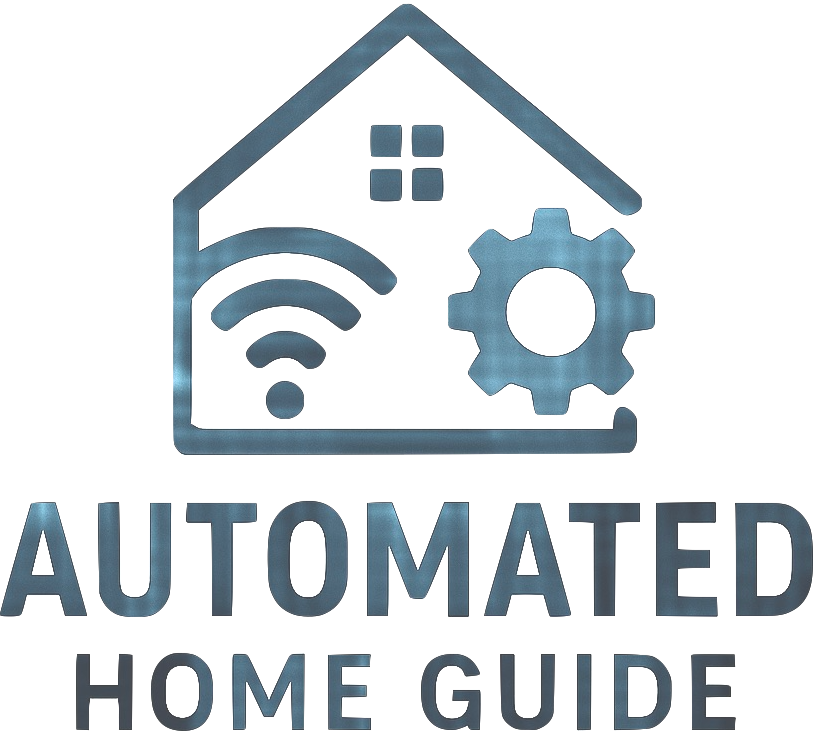
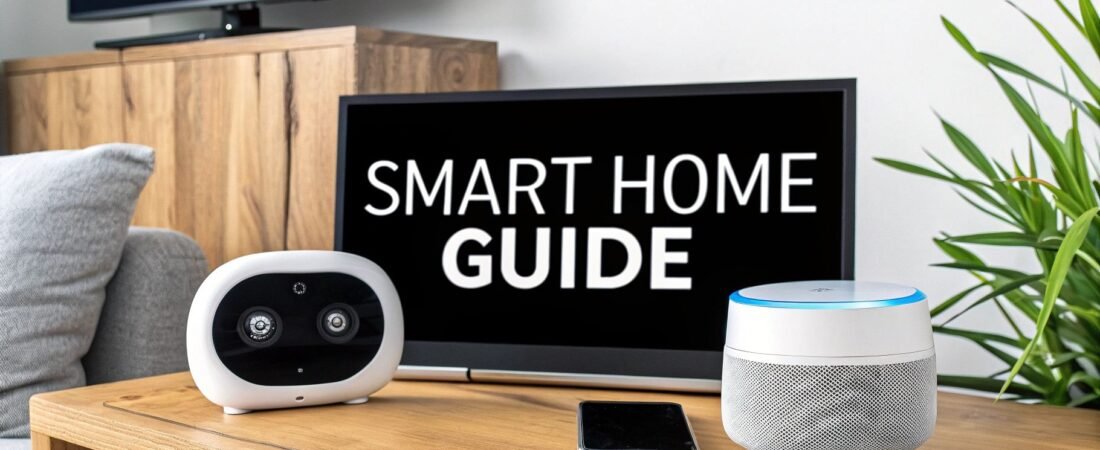
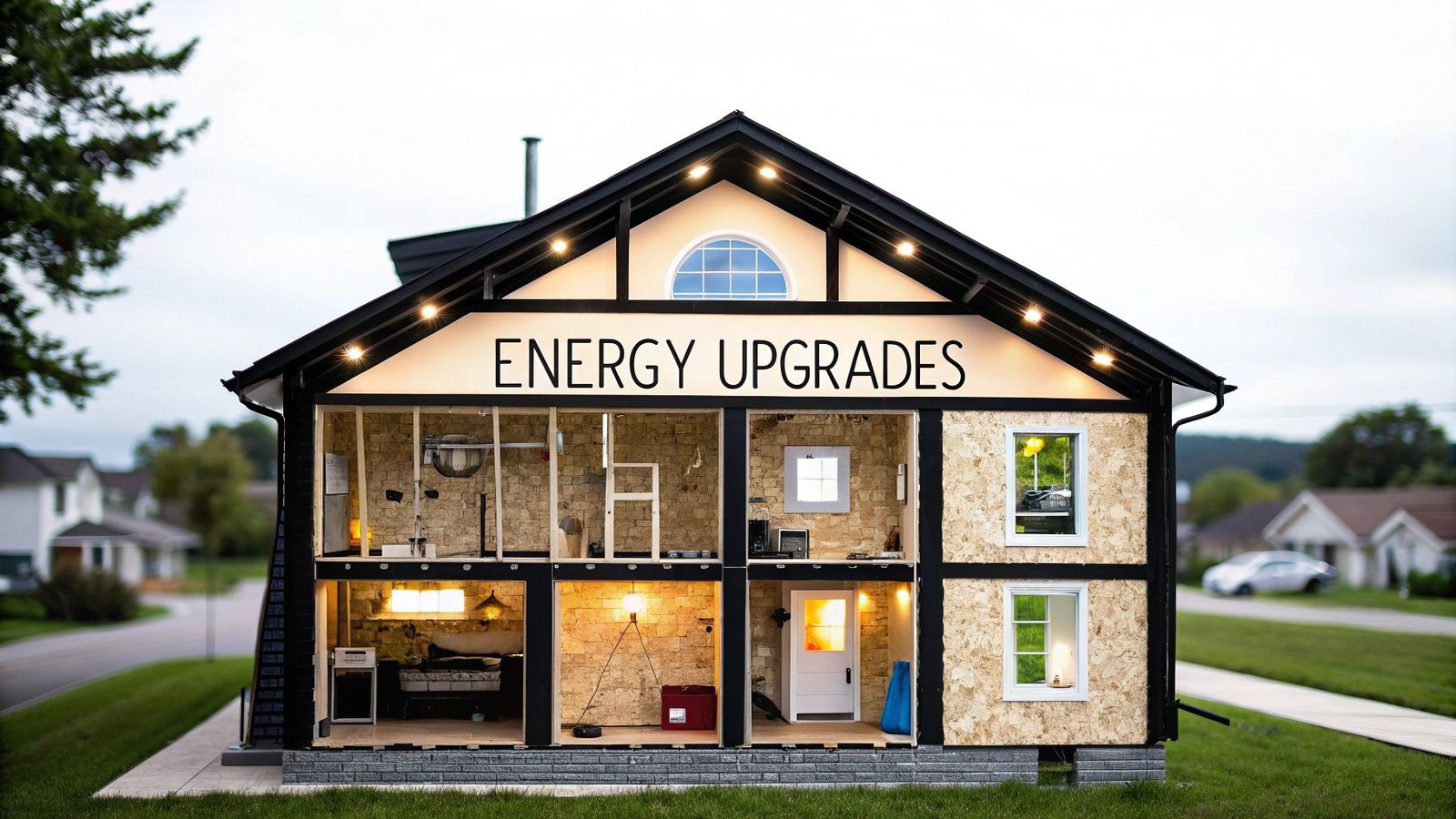
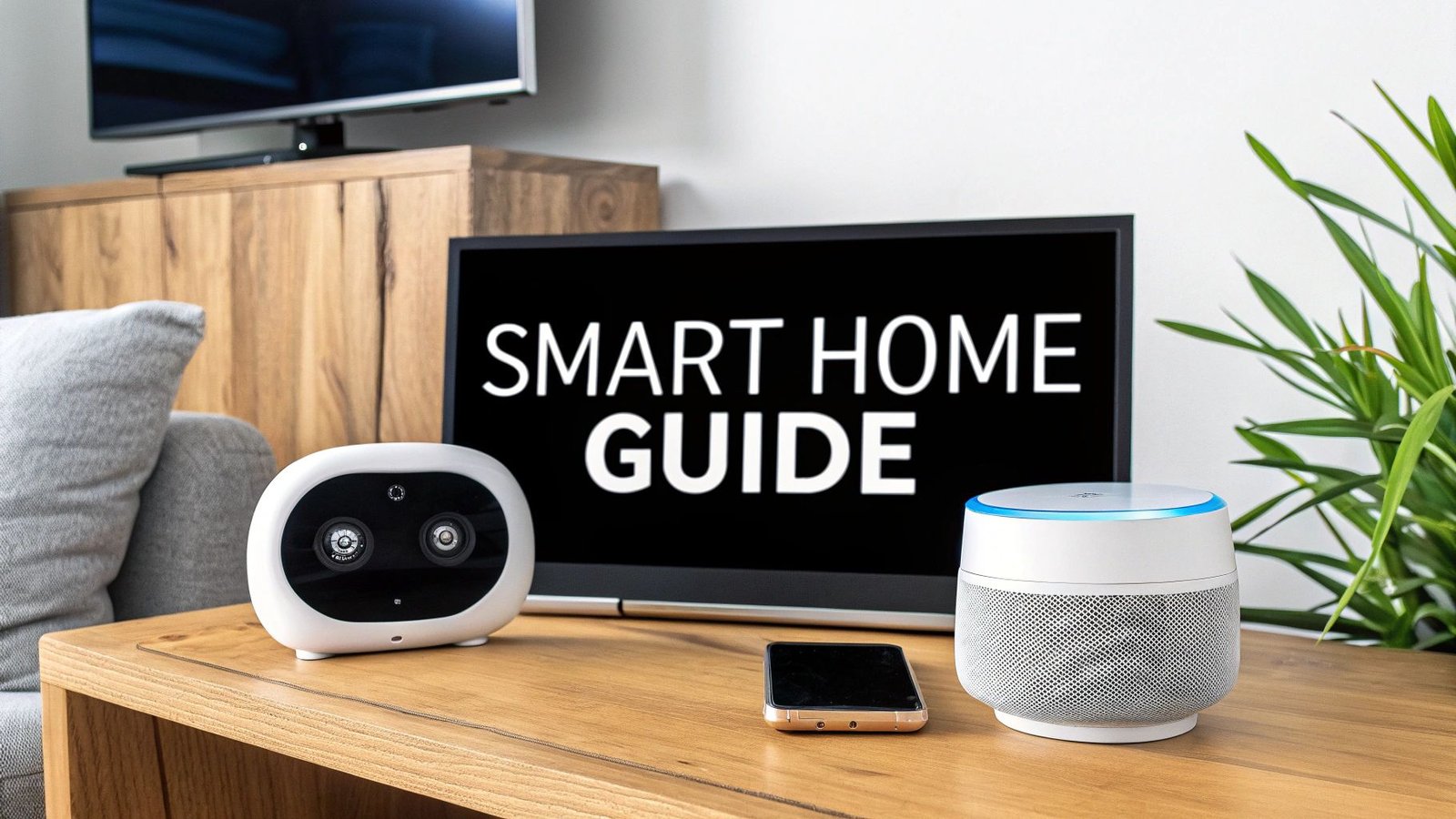
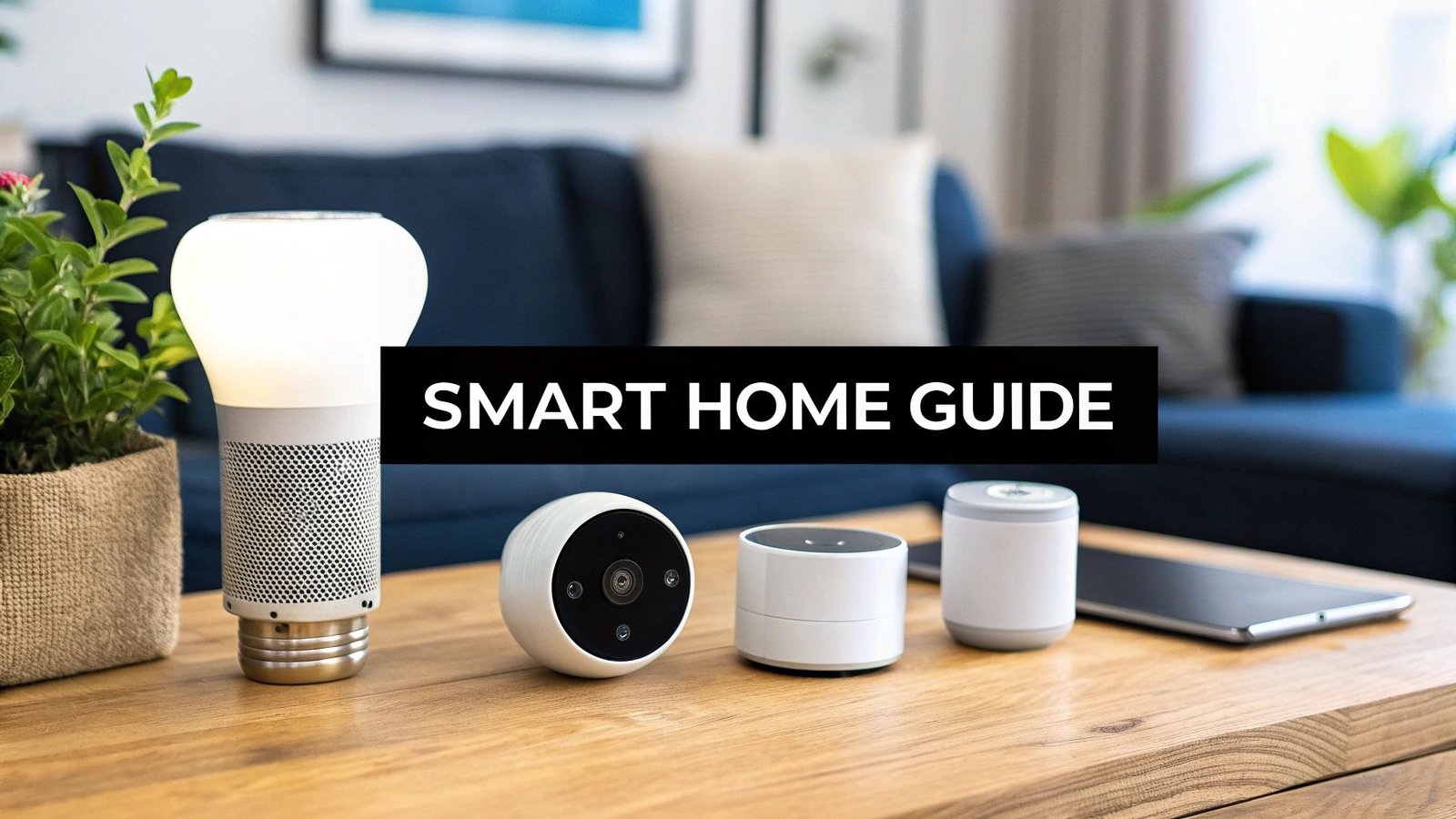
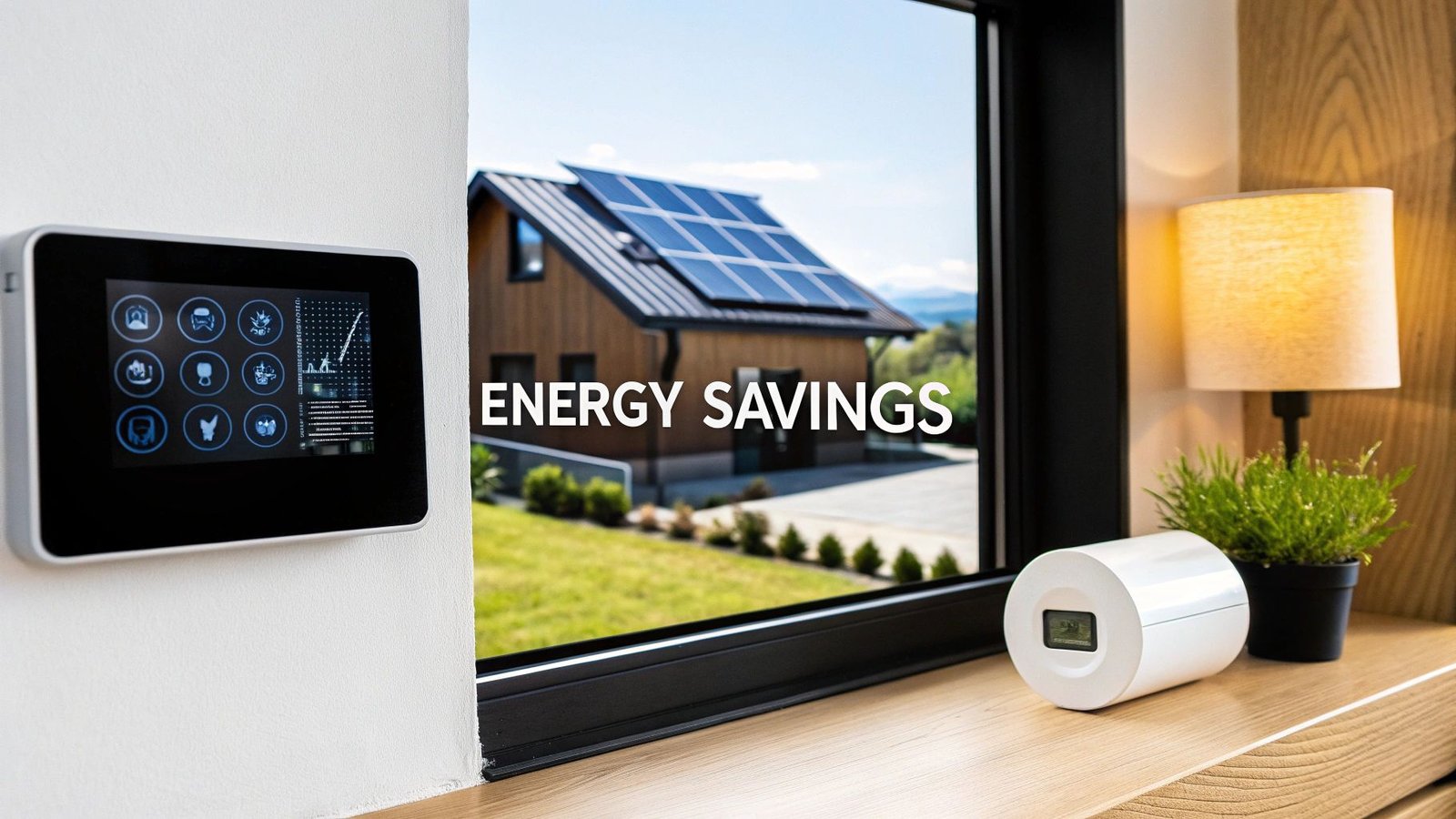
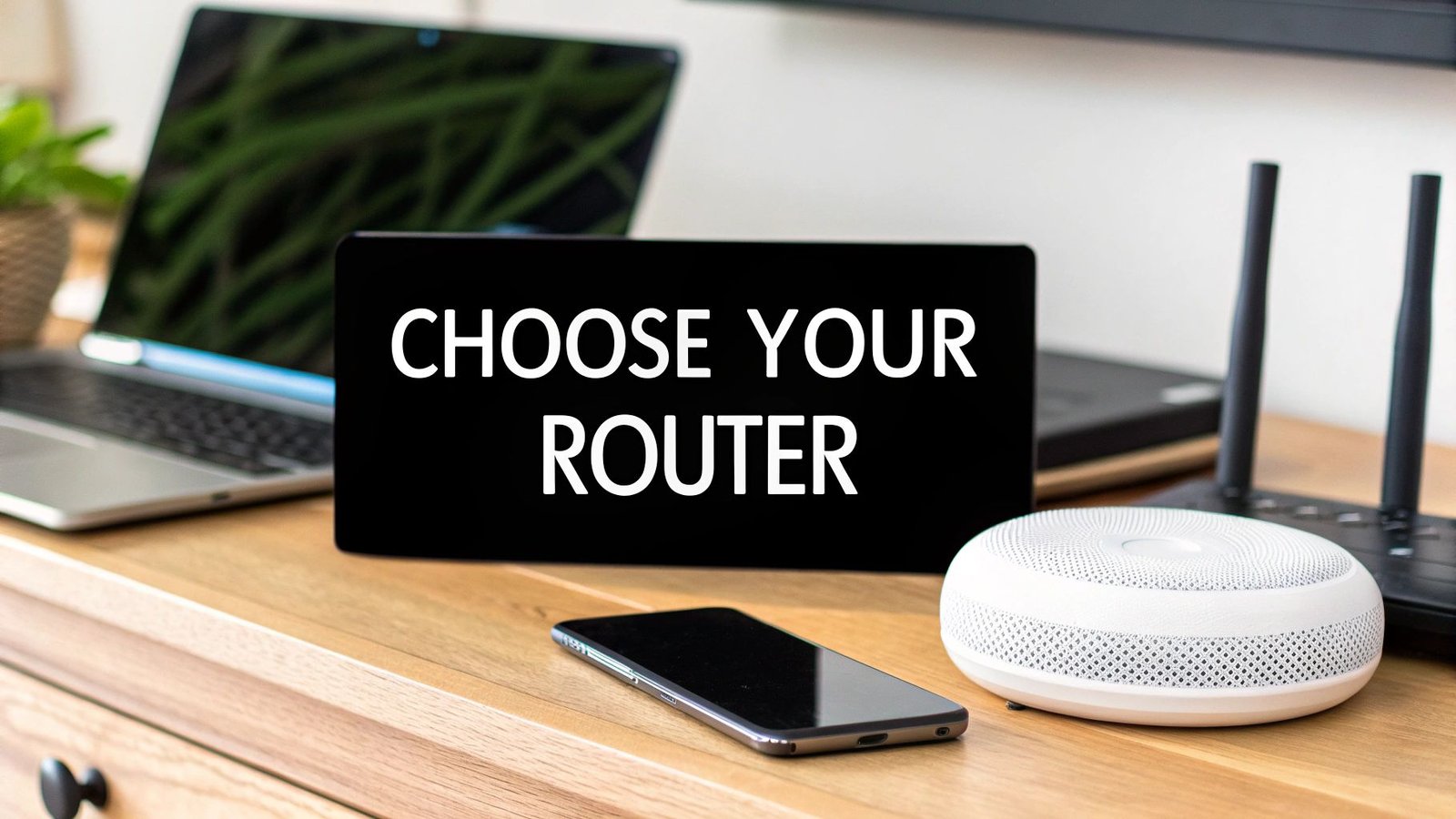
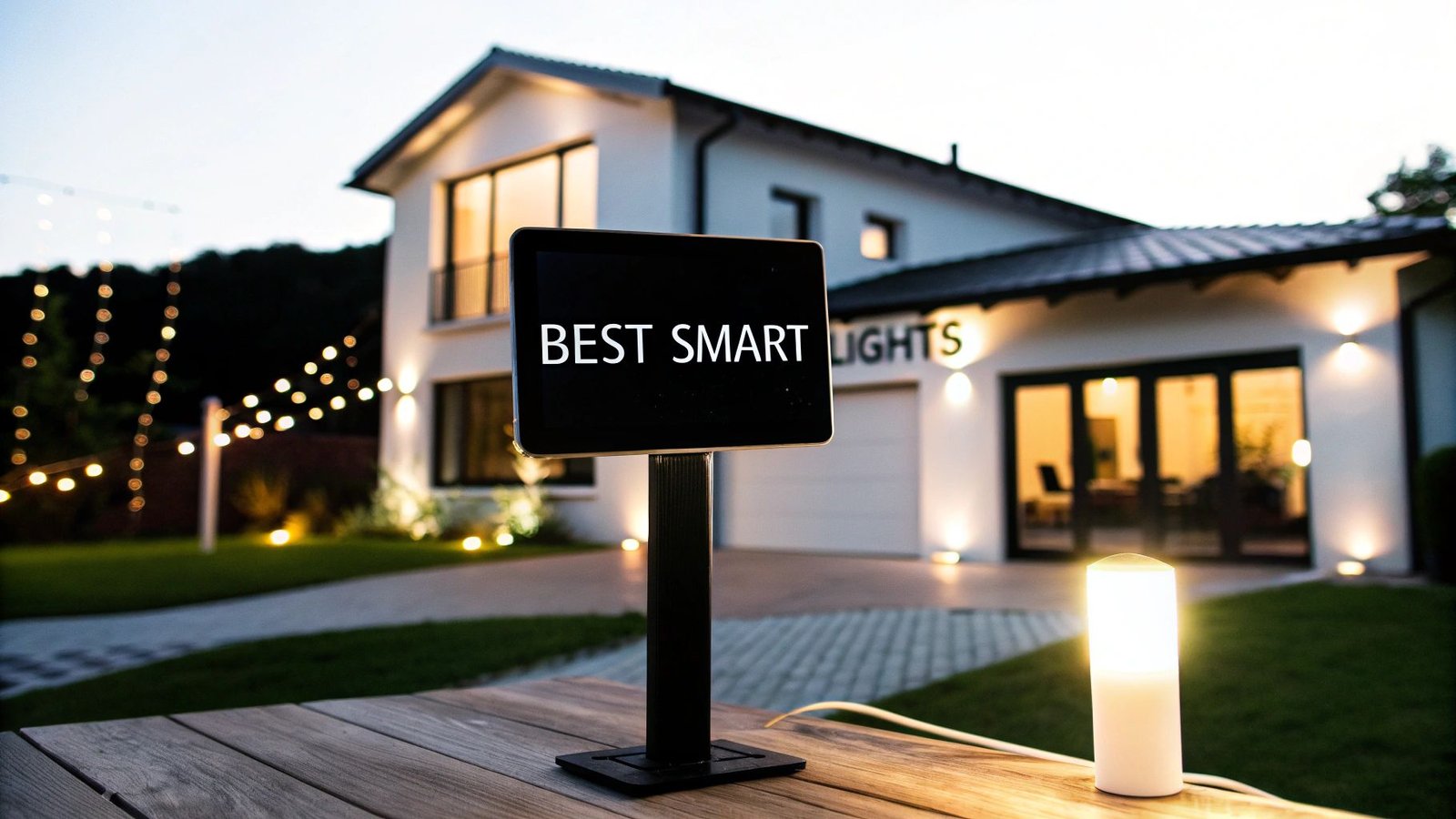
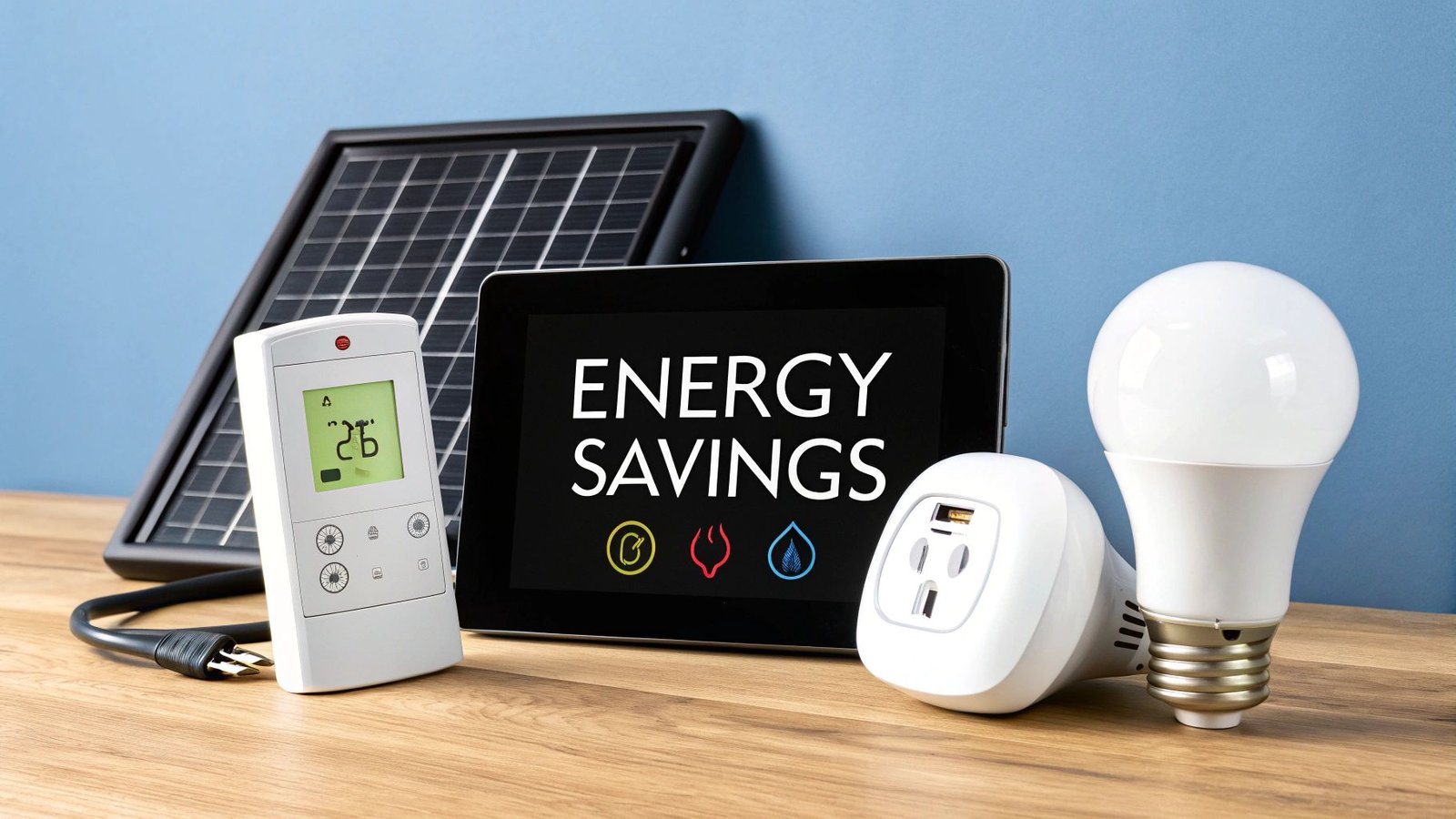
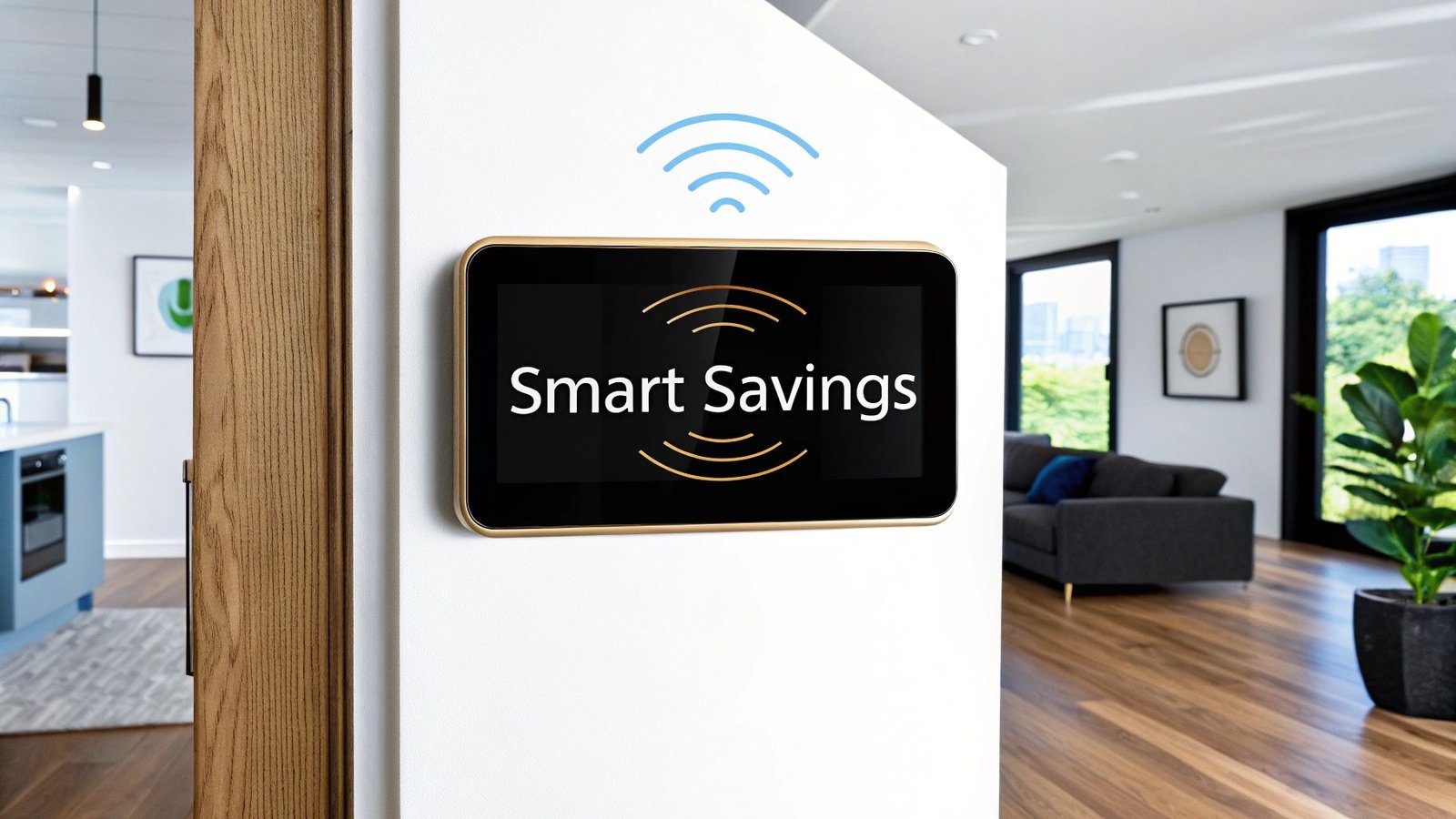
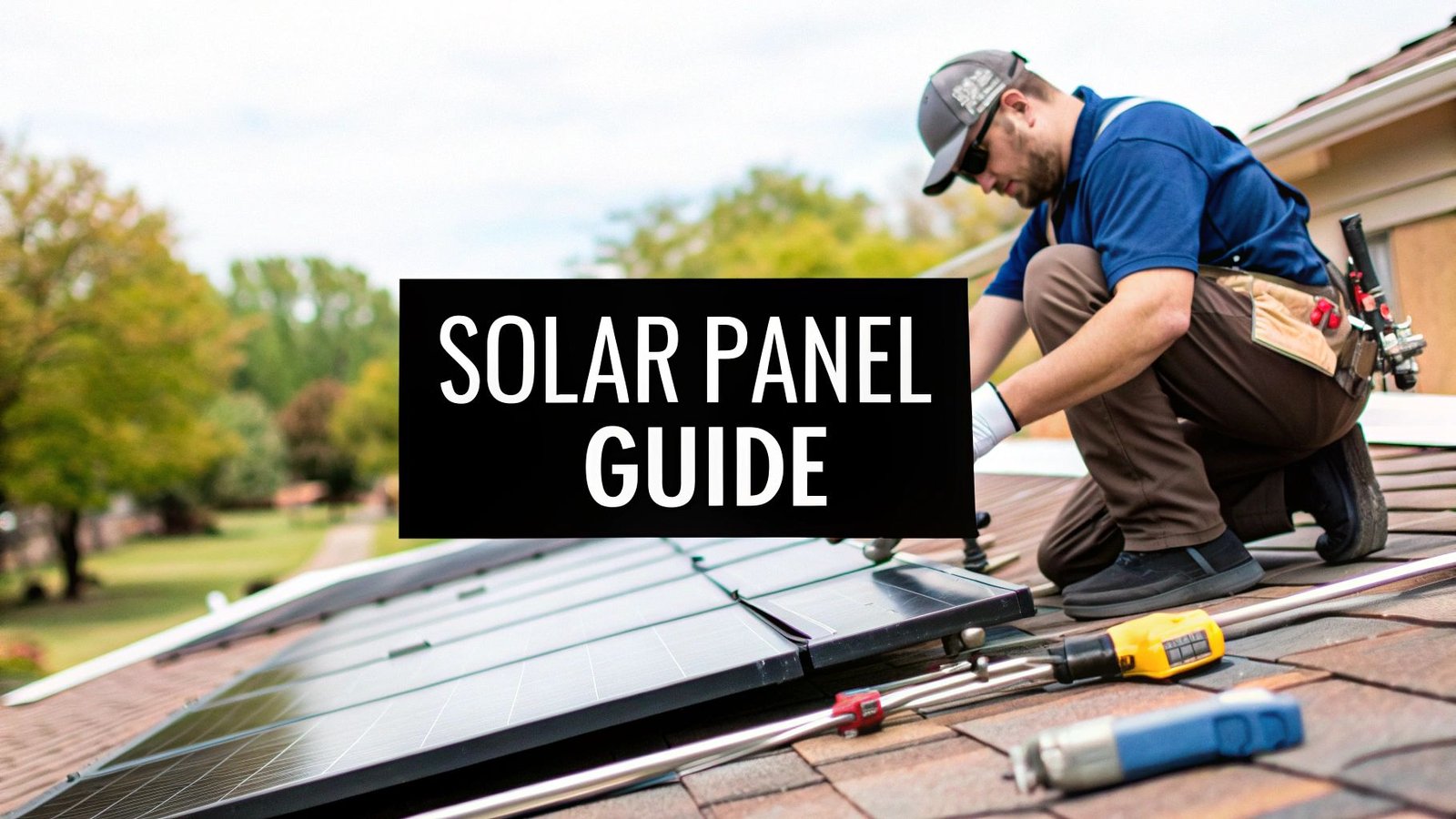
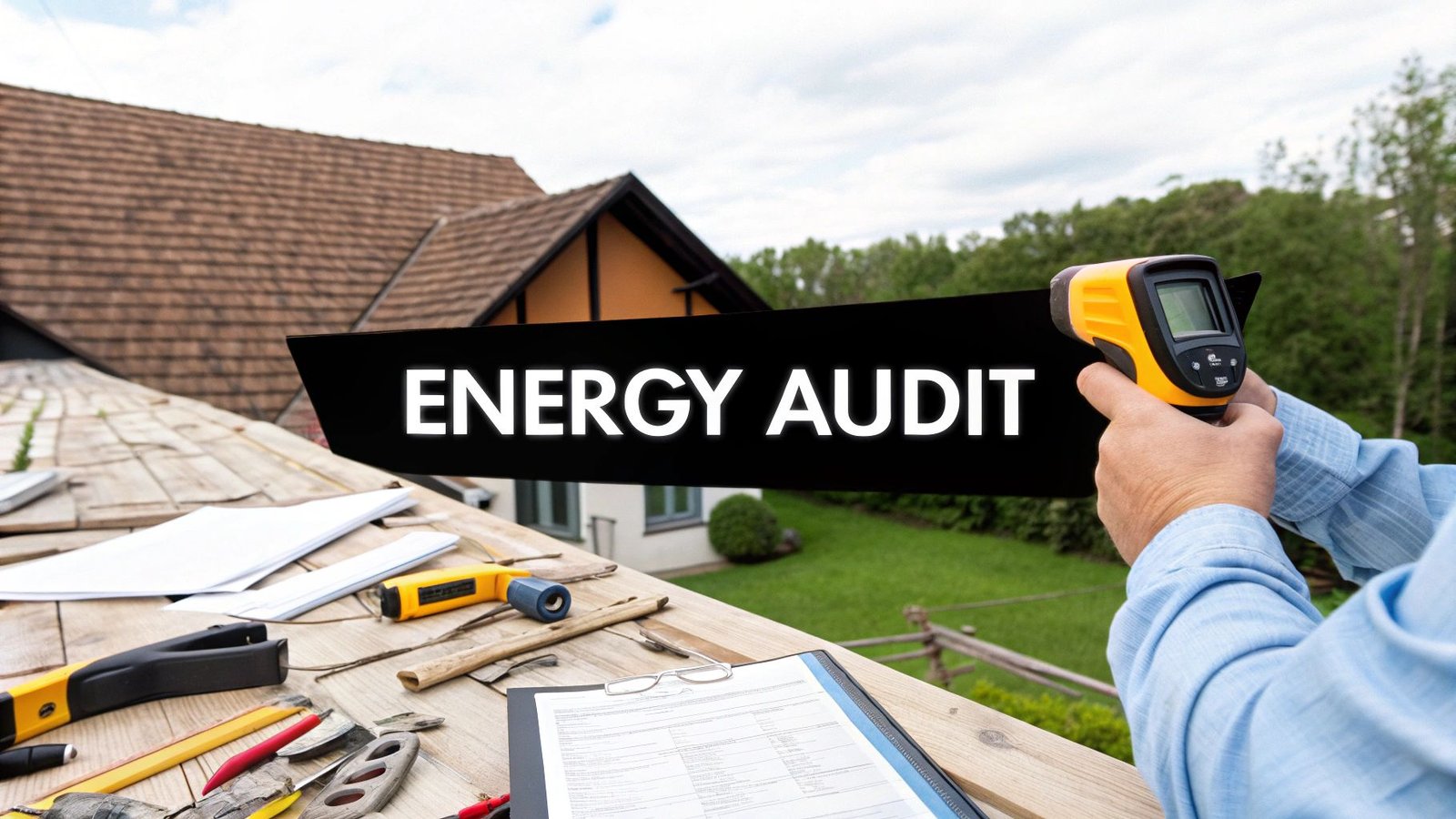
Leave a Reply